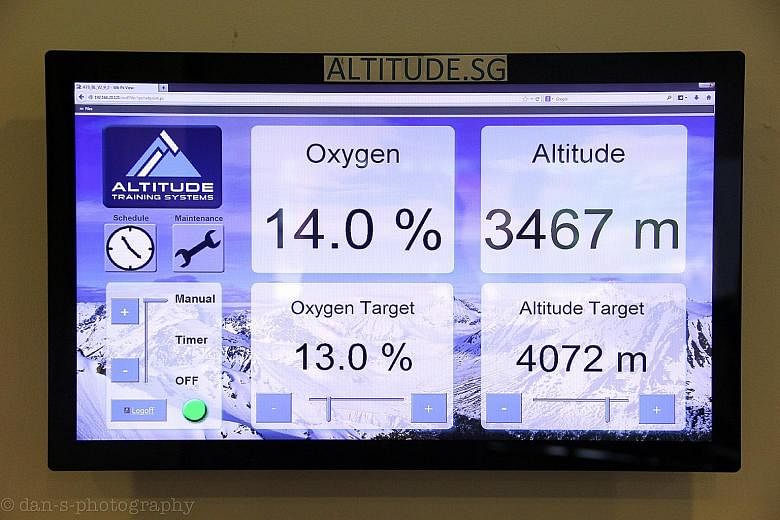Since the Altitude House at the Singapore Sports Institute opened late last year, a total of 48 athletes, including seven world-class swimmers from overseas, have used it.
They practised the live high, train low model, where they spend most of their day in a high-altitude environment but train at or near sea level.
National kayaker Stephenie Chen, 25, said living in the house, which simulates an environment of 2,500m above sea level, had not caused her any discomfort.
Instead, she could see the difference her stay made in her fitness after spending 25 days there.
"The biggest difference I saw in terms of performance was my stamina had improved and I was able to last longer for higher- intensity workouts," she said.
This approach is useful for athletes who want to improve their performance at sea level, where most competitions are held, said Dr Frankie Tan, director of the Singapore Sports Institute.
"The harmful effects are minimal. Sleeping at 2,500m is like doing so in the cabin of a long-haul flight."
This model came about because at high altitudes, athletes found it hard to train at the same intensity as they did at sea level.
Dr Tan said the institute is doing a year-long study on a group of national athletes to monitor the effects of daily endurance training and simulated altitude exposure.
The results so far are promising.
A key marker being measured is the total haemoglobin (the protein in red blood cells that transport oxygen) mass in the blood.
Dr Tan said there is an increase in the Hbmass of the athletes studied. "When this is achieved, their aerobic capacity (endurance) can be enhanced."
The body adapts to the low- oxygen environment at high altitudes by increasing the amount of red blood cells and haemoglobin in the blood. This allows the body to transport more oxygen to the muscles.
Apart from the Altitude House, the institute also has an Environmental Chamber for exercise training in simulated altitude conditions. It will open this facility to national athletes at a later date.
Preparing heart for next heart attack
A device designed to offer intermittent hypoxic training was launched at the Medical Fair Asia 2016 in Singapore last week.
Called ReOxy, one of its aims is to help increase the exercise tolerance of patients suffering from coronary heart disease.
Intermittent hypoxia appears to work mainly through ischaemic preconditioning, said Dr Tong Khim Leng, Changi General Hospital's chief of cardiology.
By depriving the heart of oxygen intermittently, it actually prepares (and conditions) the heart for the next heart attack, so that there will be less damage when that happens, she said. The exact mechanism of how the heart does this is uncertain.
"Clearly, this therapy needs to be balanced against the potential risks, particularly in elderly patients," Dr Tong said.
Heart patients do not tolerate hypoxia well and they usually have co-morbidities, such as respiratory problems in smokers, she said.
"The deprivation of oxygen can trigger arrhythmias, heart attacks and even cardiac arrests in patients with pre- existing weak heart or severe blockages."
Dr Tong said the therapy is definitely not in the guidelines for patients with coronary artery disease. Animal studies and some small studies on humans have shown that intermittent hypoxic training can help increase the exercise tolerance of coronary heart disease patients.
However, further studies are necessary before the therapy can be adopted as a standard therapy for heart patients.
Heart patients who are interested in the therapy should check with their cardiologist, she added.
Joyce Teo


